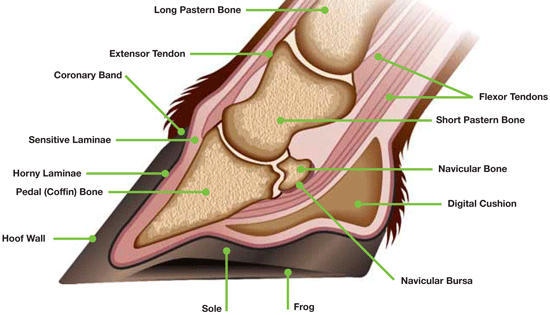Laminitis

Cross-section of a hoof.
Laminitis is a frequent cause of lameness in horses, particularly ponies.
It is defined as an inflammation of the equine lamina. The lamina hold up the entire weight of the horse, spread over all four limbs.
What causes Laminitis?
Inflammation of the equine lamina can occur for a number of reasons. Probably the most common cause is obese ponies over-grazing on rich grass, particularly in the spring. However, it can also be caused by:
- Equine Cushing's disease
- Over-consumption of grain
- Concussion
- Endotoxemia, for example with concurrent strangulating colic, where a bacterial infection releases toxins into the bloodstream
- Force overload, where the horse is lame on the opposite limb and puts excessive force on the sound limb. It is particularly prevalent in large breeds such as Shire horses

Degrees of severity
Acute laminitis causes a breakdown in the attachments between the lamina. One side of the lamina is attached to the hoof, the other to the bone, and these interlock together. In severe cases laminitis can cause the lamina to become ‘unzipped’ and the pedal bone may become detached from the hoof.

Solar penetration Laminitis.
In the case of a rotation, this separation of the lamina occurs mostly at the dorsal - distal aspect (the lowest tip at the front) of the hoof. This is very common in ponies where the pedal bone may cause a convex deformity of the sole and in severe cases penetrate it. However, in the case of “sinkers”, this detachment occurs all the way around the hoof.
This is more common in heavy horses, where a high level of detachment means that the prognosis is generally poor.
Laminitis and the older horse
Older ponies with recurrent bouts of laminitis often have Cushing’s disease or metabolic syndrome. In such cases, management of laminitis bouts may well be successful. However, treatment of the underlying disease is essential in order to gain some control over the recurrence of the condition.
Treatment of laminitis
The majority of laminitis cases will be treated with:
- A period of stall rest
- NSAIDs for their anti-inflammatory and analgesic effects
- Vasodilators (acepromazine or glyceryl trinitrate)
- Frog supports (usually with a deep bedding)
What are frog supports?
Ready-made frog supports can be formed from Styrofoam or rubber, or they can be custom-made using a bandage taped to the frog. The aim of these adjuncts is to prevent further rotation of the pedal bone by providing gentle pressure. Inappropriate pressure can cause further pain, so great care must be taken when using such aids.
With all foot conditions it is important that vets and farriers work together. Remedial shoeing can be pivotal in the recovery and prevention of recurrence of any painful condition.

